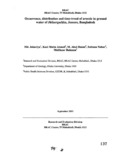| dc.contributor.author | Jakariya, Md. | |
| dc.contributor.author | Ahmed, Kazi Matin | |
| dc.contributor.author | Hasan, M. Abul | |
| dc.contributor.author | Nahar, Sultana | |
| dc.contributor.author | Rahman, Mahfuzar | |
| dc.date.accessioned | 2019-12-23T09:06:41Z | |
| dc.date.available | 2019-12-23T09:06:41Z | |
| dc.date.issued | 2003-09 | |
| dc.identifier.citation | Jakariya, M., Ahmed, K. M., Hasan, M. A., Nahar, S., & Rahman, M. (2003, September). Occurrence, distribution and time-trend of arsenic in ground water of Jhikorgachha, Jessore, Bangladesh. Research Reports (2003): Social Studies, Vol – XXXI, 137–150. | en_US |
| dc.identifier.uri | http://hdl.handle.net/10361/13335 | |
| dc.description.abstract | In order to assess the arsenic concentration change over time, water from a total of 246
tubewells Jhikargachha upazila of Jessore district were tested using atomic absorption
spectrophotometer in two different periods of time. The main objective of the study was to
develop a sustainable and affordable arsenic testing protocol for the arsenic affected
communities of the country. While measuring groundwater arsenic concentration change over
time, local hydrogeology and geostatistical relationship with arsenic were also analysed. It
has been observed that movement of groundwater, according to elevation contour maps of
dry and wet seasons of 1996, is from the central part of the study area towards the peripheral
rivers. A relationship between arsenic distribution patterns and groundwater movement,
though not obvious, could be established. Geostatistical analyses have been performed to
investigate relationships between arsenic in groundwater with different well and aquifer
parameters. A positive co-relation was observed between well depth vs. percentage of arsenic
contaminated wells i.e. a general increasing trend of contaminated wells from 30 to 60m
(~=0.81). This increasing trend changes at depth greater than 60m. The arsenic concentration
results reveal that the highest number of tube well water showed change in concentration level
in either case (i.e. increased or decreased). The highest increase was 91 J..lg/L and lowest
decrease was 128.20 J..lg/L. This trend indicates that arsenic concentration in tubewell water
can change in both directions but the tendency to reduce concentratio~ levels of arsenic in the
analysed water was comparatively high. However, the findings of the study did not show any
strong indication about changing the concentration level of arsenic in tubewell water. | en_US |
| dc.language.iso | en | en_US |
| dc.publisher | BRAC Research and Evaluation Division (RED) | en_US |
| dc.subject | Arsenic | en_US |
| dc.subject | Ground water | en_US |
| dc.subject | Jhikorgachha | en_US |
| dc.subject | Jessore | en_US |
| dc.subject | Drinking water | en_US |
| dc.subject | Mitigation | en_US |
| dc.subject | Hydrogeology | en_US |
| dc.subject | Goo-statistical | en_US |
| dc.subject.lcsh | Arsenic--Environmental aspects | |
| dc.subject.lcsh | Arsenic--Toxicology | |
| dc.subject.lcsh | Water--Pollution | |
| dc.subject.lcsh | Water--Purification--Arsenic removal | |
| dc.title | Occurrence, distribution and time-trend of arsenic in ground water of Jhikorgachha, Jessore, Bangladesh | en_US |
| dc.type | Research report | en_US |

